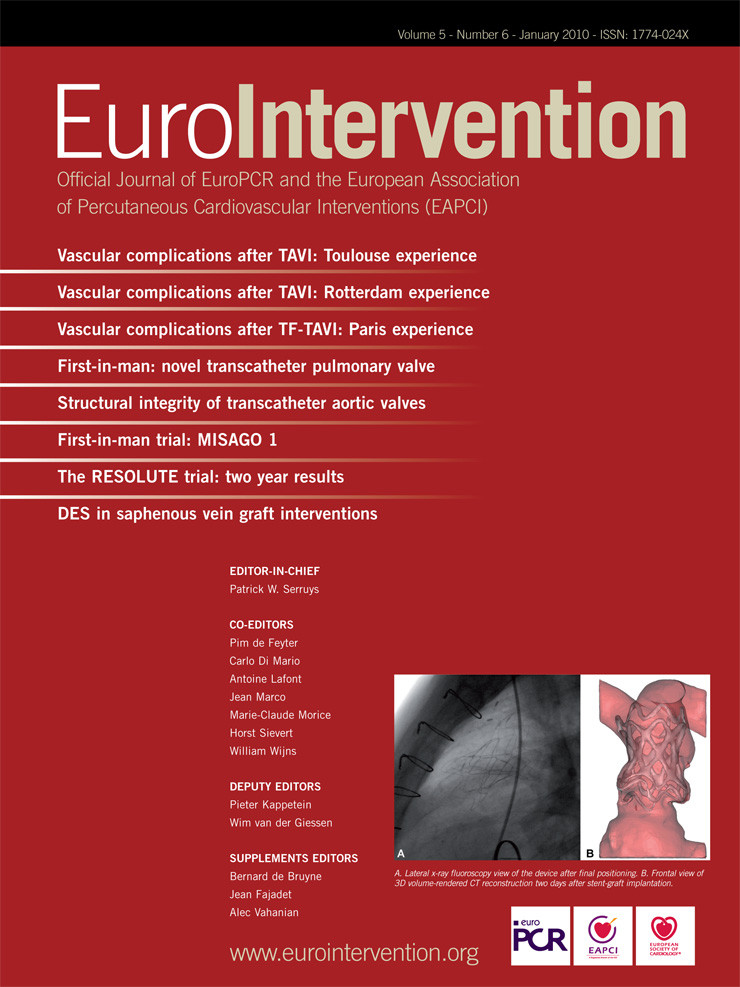Dear colleagues,
It seems the very soul of interventional cardiology is its dynamic and ever-changing nature. Transcatheter aortic valve implantation (TAVI) is one of those “reasonable” dreams, one that has become a reality, with the pioneering work of Alain Cribier which gave a new perspective to patients who were not healthy enough to overcome, or even qualify for, classic aortic valve surgery with all the implications attached to it: sternotomy, heart-lung machines, cardioplegia, deep general anaesthesia, etc.
Today, with TAVI, we are at the verge of a new era, as we see this technique evolve through attentive clinical practice and trial into a very attractive, minimally invasive strategy that has yet to reach its limits.
The world according to TAVI
There is no doubt that the TAVI landscape is expanding, and yet, we cannot fail to remark that this excitement also has generated some confusion. Internationally, different groups are exploring these new and challenging strategies, eager to share their experience and results with their peers. Unfortunately, at the present time, the comparison of data between these different groups remains difficult because there is simply no uniformity in how to define and present TAVI results. To create some kind of order out of this chaos, several academic research groups have joined forces under the umbrella of the Valvular Academic Research Consortium (VARC). This type of collaboration has a proven track record; earlier, the Academic Research Consortium (ARC) was born of a similar need to elaborate uniform definitions in the field of stent thrombosis. Today, the ARC definitions are widely accepted, making interpretation and comparison of a wide range of studies from throughout the world on present and future stent technology more feasible. Similarly, VARC has the ambition to generate a consensus statement on definitions applicable to TAVI research in general.
TAVI, today
Two device platforms have CE Mark approval: the Edwards SAPIEN™ Valve (Edwards Lifesciences, Irvine, CA, USA) and the Medtronic CoreValve System® (Medtronic Inc., Minneapolis, MN, USA). We are all aware that these TAVI strategies are neither benign nor easy procedures, with TAVI’s current practitioners needing to use meticulously studied techniques, executing their strategies with perfection.
In this issue of EuroIntervention, we have chosen to present reports on vascular access site complications in TAVI from three renowned centres in Europe in the interest of underlining ongoing work, as well as furthering TAVI’s clinical and scientific development. The patient numbers per centre might not be great; yet we believe that the combination of these reports provides an excellent idea of the different challenges facing TAVI today. Several issues arose when interpreting the various results.
First of all, vascular complications were defined by the three groups in a variety of ways. Albeit trivial at first glance, these differences in reporting complications leads to significant over and/or underestimating, depending on the definition used.
The second stumbling block to a truly cohesive view is the variability in patient population. The logistic EuroSCORE (to mention one of the surgical risk scores commonly used) was lower here in Rotterdam when compared to the two French centres. Notwithstanding these differences, which only put in question the easy comparison of results, it should be noted that TAVI-related vascular events are relatively easy to manage, either percutaneously or with limited surgical intervention.
Stent fracture is a concept that has gained considerable attention in coronary stent literature, and in the following pages Piazza et al bring this concept into the TAVI arena, where frame fatigue and fracture are definitely seen to be legitimate concerns.
The future
Almost daily we hear of new device iterations and technical refinements, there is a sure momentum in this field today, with the expansion of TAVI technology to lower risk patients with aortic stenosis clearly on the horizon.
Transcatheter treatments have also become key strategies in the arena of congenital heart disease. Philip Bonhoeffer reported on the first-in-man percutaneous pulmonary valve implantation in 2000; unfortunately, in the majority of patients, the right ventricular outflow tract and/or pulmonary trunk grew too wide for the current CE marked Melody device (Medtronic Inc., Minneapolis, MN, USA), thus making surgery inevitable. Bonhoeffer and co-workers have consecrated considerable time and effort in their pioneering –and continuing– work on this technique, and in this edition of EuroIntervention we present their first-in-man experience of implanting a pulmonary valve customised to the patient’s anatomic dimensions. This procedure is based on the integration of new 4-dimensional imaging reconstruction and undoubtedly, this FIM-experience will open the door for other transcatheter treatment options for these younger patients along with surgery. Phillip Bonhoeffer also offers his own viewpoint on reseach and development in an editorial following this one, which I am sure you will find intriguing.
Even from our vantage point it is difficult to predict where the transcatheter revolution will take us in the following years. As we move, if only in our scientific dreams, from aortic and pulmonary valve replacements to atrioventricular valve replacements, we ask you, our readers to join us here in these pages...share with us these dreams and help make –above all– the excellent care of our patients, a continually evolving reality.

